12 Creative Ways To Use Up Almond Meal
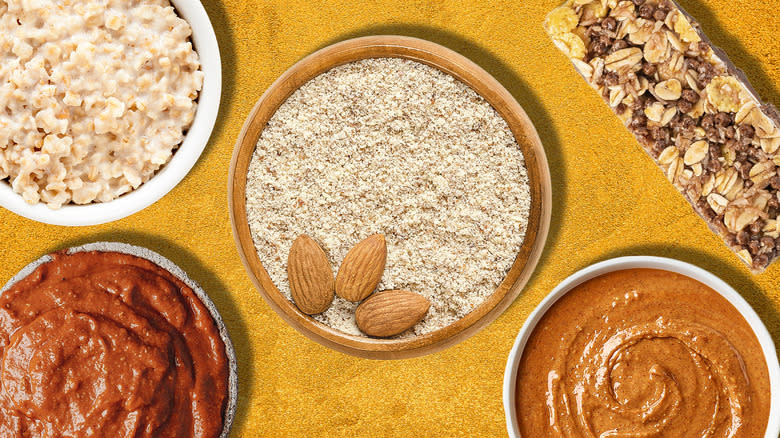
If you've ever made your own almond milk or have experimented with low-carb cooking, you're likely familiar with almond meal -- and have had a surplus of it on your hands a time or two. Almond meal, not to be confused with almond flour, is made from ground whole almonds (including the skins). It has a distinct crumbly texture and subtly sweet flavor. Though it is typically regarded as a byproduct of making almond milk, almond meal has a vast array of culinary applications that make it an entirely practical, and utterly tasty, ingredient to have on hand.
From lending a nutty and rustic touch to baked goods to serving as an excellent low-carb and gluten-free alternative to wheat-based ingredients in savory recipes, almond meal proves itself to be useful in multiple areas. It doesn't just impart an extra dimension of flavor and texture to foods and drinks, but it is also packed protein and fiber for an impressive nutritional boost.
There are multiple ways to highlight the delicate, nutty taste of almond meal, as well as more subtle approaches that use the ingredient to add texture or reach a certain consistency. You're sure to find that this versatile ingredient can provide a unique touch to everything from hearty breakfasts to smoky sauces.
Read more: 30 Types Of Cake, Explained
Make A Nutty Topping For Desserts
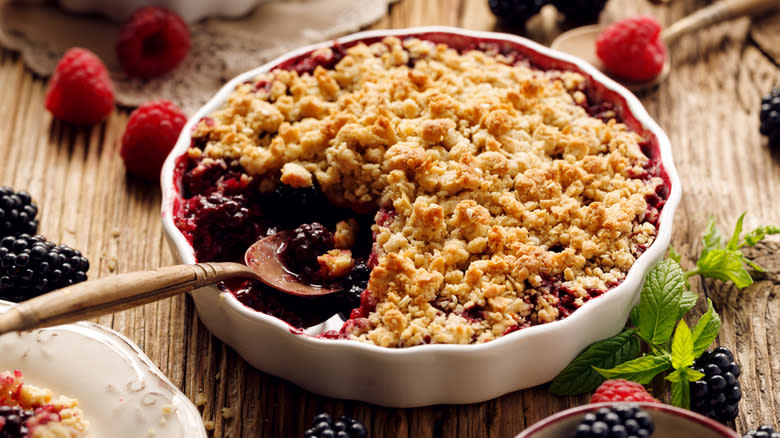
Almond meal is perfect for adding flavor and texture to pies, tarts, and cupcakes -- especially in the form of an attractive and inviting crumble. While such crumbles and streusels are usually made with flour, butter, and sugar, recipes can be adapted to suit a specific flavor, dessert, or ingredient -- like almond meal. Almond meal is a particularly useful addition to crumbles, where it lends a delicious and delicate nuttiness. But, it also allows a ton of room for playing with the recipe to suit whatever you're making.
The texture of almond meal is well suited to fulfill the role of wheat flour. It can also be a useful substitute if you are looking to keep things gluten-free or reduce the number of carbs in your sweet treats. Simply combine almond meal with sugar and melted butter until the mix reaches your desired consistency. Be sure to leave some larger clumps for texture and refrigerate the crumbs until they are ready to be sprinkled over whatever baked good you want to add an embellishment to.
You can also add extra flavor to the mix by incorporating various spices and fresh ingredients. Vanilla extract and lemon zest lend a freshness that is perfect for sprinkling over fruity crisps, while a teaspoon of cinnamon provides the ideal sweet and spicy balance that works beautifully atop a cream cheese-frosted carrot cake.
Incorporate It Into Smoothies
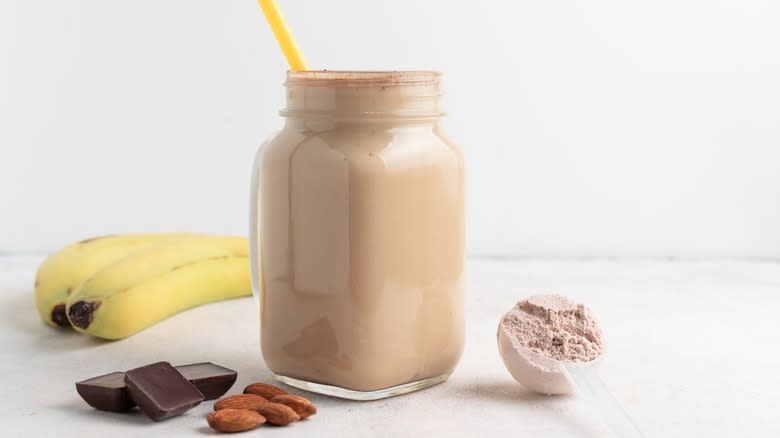
There's no doubt that almonds are an excellent, protein packed addition to smoothies. Not only do almonds help add a tasty nuttiness and subtle sweetness, but it will also imbue your smoothies with protein, fiber, and healthy fats to keep you feeling full long after you drink it. While you can add whole almonds to your smoothie (just be careful not to break your blender), or use almond milk as the liquid base for your drink, almond meal is arguably the better choice. It blends seamlessly with other ingredients, while also adding extra fiber -- thanks to the intact skins and pulp.
You can add a tablespoon or two of almond meal into the blender for an extra boost of both flavor and nutrients. The ground almonds pair particularly well with juicy stone fruits, such as apricots, dates, and cherries, or rich and deep dark chocolate. If you prefer a more subtle taste, you can, of course, opt for a little less almond meal, and add an extra source of sweetness, such as honey or agave syrup, to help balance out the distinct flavor profile of the almond meal.
Turn Leftover Almond Meal Into A Cheesecake Crust
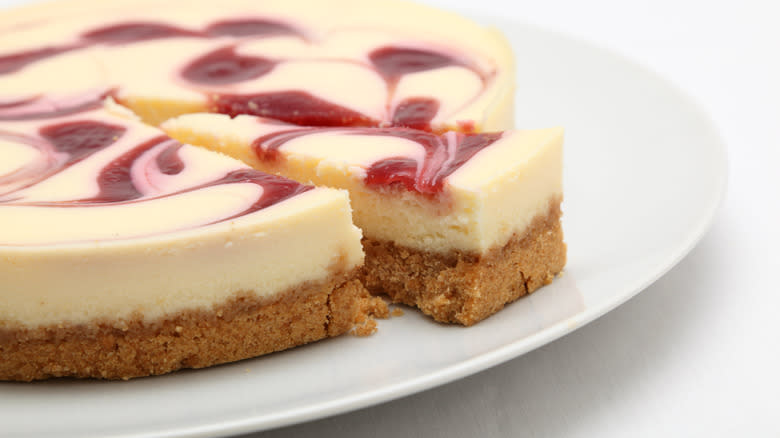
The buttery, sweet, and crumbly base of a proper cheesecake is arguably just as important as its rich and creamy topping. Graham crackers are traditionally used for the ideal sweet and crunchy base, but your leftover almond meal can serve the same purpose.
Almond meal has the same fine, but still slightly coarse, texture as crushed graham crackers, meaning it produces a similar consistency when combined with butter and pressed into a springform pan. While this does make it an ideal substitute if you're after a lower carb alternative to traditional pie crust, an almond meal-based crust shouldn't just be reserved for the times when you're trying to add more fiber to your diet. Rather, almond meal imparts a delicious nuttiness and delicate taste on cheesecake that beautifully complements the thick and tangy filling.
Moreover, using almond meal when making a cheesecake reduces prep and clean-up time significantly. There's no need to crush, crumble, or blend anything into finer crumbs, like you would have to do with graham crackers or cookies. Instead, you can simply mix your almond meal as-is with melted butter and a little sugar until the mixture comes together. Since almond meal can sometimes taste a little savory, you may find that you need to add a little more sugar to achieve the same level of sweetness as a cookie crust. Otherwise, the almond meal can be substituted in for graham crackers using a 1-to-1 ratio.
Add Almond Meal To Stuffing
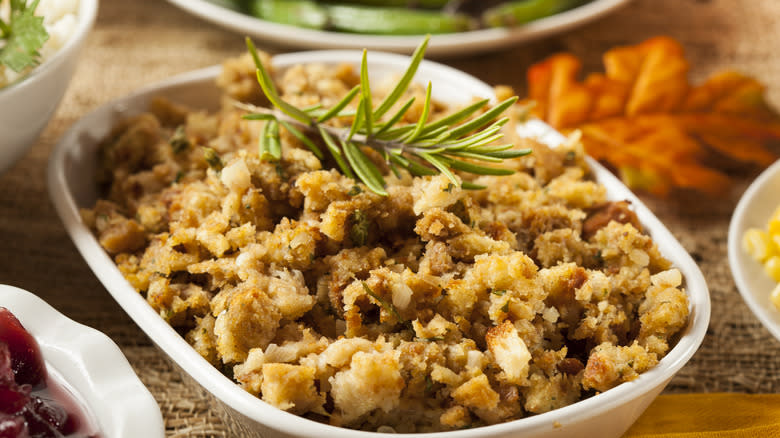
Though stuffing was intended to complement and flavor the meat or poultry encasing it, it has become somewhat of a classic in its own right. After all, what's Thanksgiving without the stuffing? What is particularly useful about the dish is its versatility; it can be prepared using a wide range of fresh ingredients, pantry essentials, and leftovers. Indeed, stale bread is commonly used to give stuffing structure and crispiness, but leftover almond meal proves itself to be another excellent choice.
Almond meal can used as a unique, nutty breadcrumb substitute, but it can also be added alongside more conventional bread-based foundations for a more subtle and delicate almond flavor. If you are substituting almond meal in for breadcrumbs entirely, you may need to adjust the amount of liquid in your recipe to accommodate for it. Almond meal is more absorbent than breadcrumbs, so you will likely find that you need to add more broth or other liquids to prevent the mixture from becoming overly dry.
Stuffing made using almond meal will work particularly well with herbs such as sage, thyme, and rosemary, and other sweet ingredients like dried fruit and apples for a touch of freshness. Though, you can use whatever you have on hand to make a crumbly and tasty stuffing with an extra bit of decadence.
Make Your Own Granola Bars
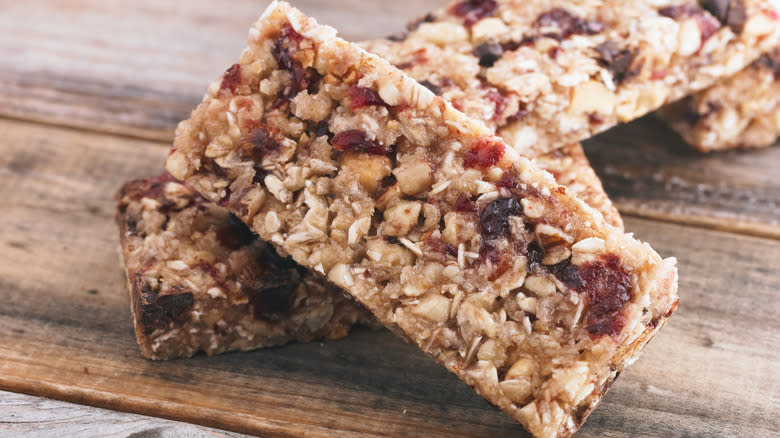
Granola bars are a great on-the-go breakfast or a healthy afternoon snack. One way to add an extra boost of nutrients and flavor is to use almond meal. Not only does this nutty ingredient make to you feel full, thanks to a hearty helping of fiber and protein, but it also adds a interesting texture and consistency to oat-based granola bars.
You can mix leftover almond meal together with oats and whatever other wet or dry ingredients you have, press the mix into a baking dish, and gently bake it until it starts to crisp. Or, omit the oats entirely and take inspiration from other grains, like in our recipe for almond-quinoa energy bars. While almond meal will still bind well to the quinoa, you might find that the bars are a little denser and less chewy without oats. So, you may consider adding in bulkier ingredients, such as coconut flakes or dried fruit, to ensure a chewy and moreish bar.
Use It As An Alternative For Breadcrumbs
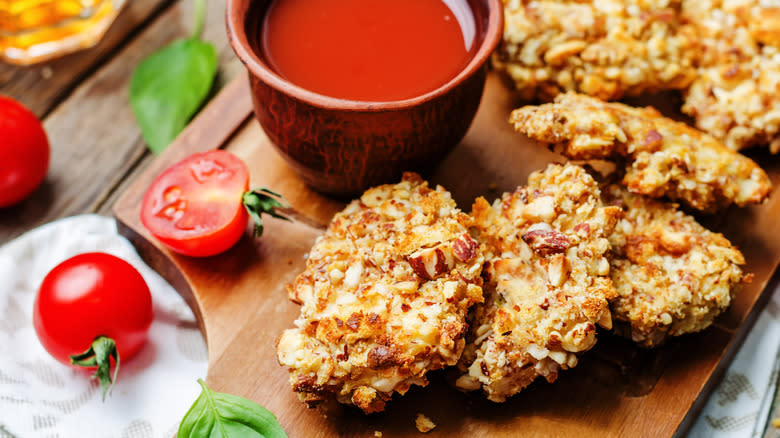
Almond meal is arguably one of the best gluten-free alternatives for breadcrumbs. It has a distinctive earthy and slightly sweet taste and a texture that results in a thick and dense coating on your favorite protein. You can use almond meal in the same way as regular breadcrumbs; just dredge the item in flour and then into the beaten egg before coating it in the almond meal. It makes for a particularly tasty, crusty topping for pork or a suitable option for coating and frying chicken in.
Unlike more neutral-tasting breadcrumbs, almond meal is brimming with flavor. So, you don't need to add any extra ingredients or seasonings before you use it to coat anything, which is useful if you're after a quick and fuss-free meal that still packs a punch. For extra indulgence, however, consider mixing grated Parmesan into the almond meal before coating your protein, or elevate things further with the use of fresh herbs and tasty spices.
Almond meal can fulfill the role of breadcrumbs when it comes to binding ingredients, like meatloaf and meatballs. Here, almond meal provides not only the necessary structure and stability, but also an additional source of protein and healthy fats to ensure truly filling dinners.
Enrich Your Oatmeal With It
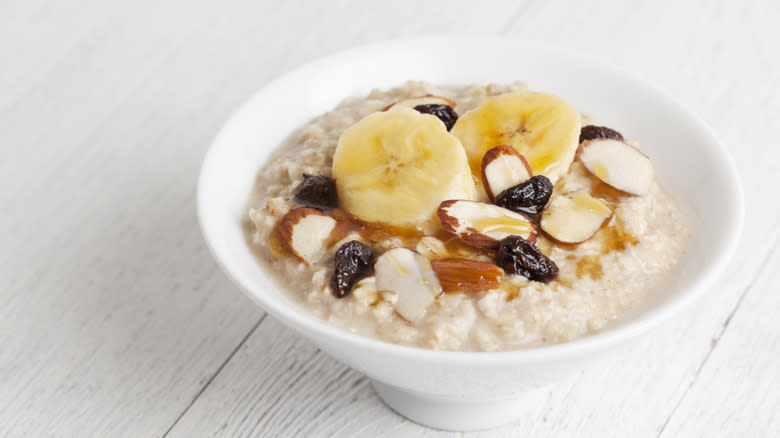
Oatmeal is an incredibly nutritious breakfast that offers an array of health benefits to help you start the day off right. But, there's no doubt that it can sometimes feel a little mundane. Although the inclusion of various toppings, both wet and dry, can help to perk things up, there's an even simpler way to shake up your regular bowl of oatmeal: almond meal.
Almond meal can be stirred into oats as they simmer to impart a unique taste. It's a simple addition that requires minimal effort, but it will result in a noticeable change in the flavor of your breakfast. Sweeteners, like honey, can be swirled in, along with a drop of vanilla extract to complement the delicate but decadent taste of the almonds. Besides an upgraded flavor, the almond meal will also add an extra layer of creaminess to your bowl, resulting in a thicker and seriously smooth texture.
Oats contain compounds that slowly release energy into the bloodstream, while almonds are a great source of protein and necessary fats. That makes the pair make for a winning combination that is well-worth a try as your new, go-to breakfast.
Combine Almond Meal With Dates For Two-Ingredient Marzipan
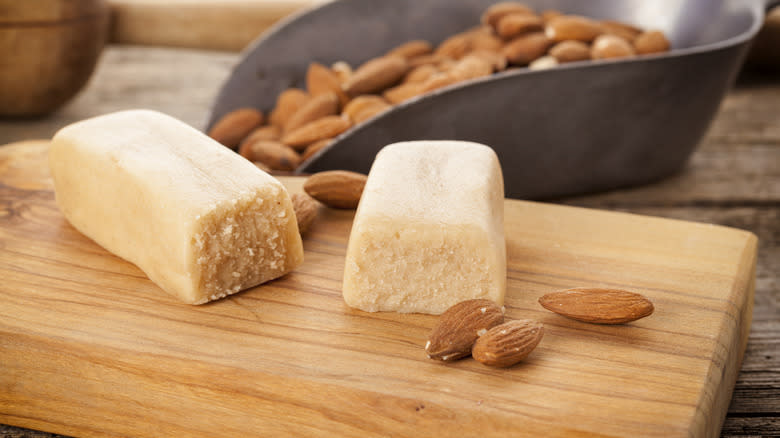
If you're after a sweet snack but are still looking to keep things light and avoid added sugar, try transforming leftover almond meal into decadent treat with the help of just one other ingredient: dates. The two ingredients come together swiftly and easily to produce a bar that is remarkably similar to marzipan. This is somewhat unsurprising, given that traditional marzipan is made of finely ground almonds, alongside sugar, corn syrup, and egg whites. Sticky sweet, caramel-like dates act as both a binding agent and natural sweetener that replaces the need for the sweetener and egg whites.
To make this take on classic marzipan, simply blitz pitted dates and almond meal in a food processor until the mixture comes together and is able to be molded. A 2-to-1 ratio of dates to almond meal should give you the consistency you need, but you may need to adjust the quantities of each until you have a well-formed and sturdy dough. You can also add a few drops of almond extract to aid in the blending process and heighten the nutty flavor. Once your dough is formed, divide it into balls or logs of your desired size, and leave them in the freezer to set. Your finished faux marzipan can be enjoyed as is, or dipped in melted chocolate for a little extra indulgence.
Bake Almond Meal Into Savory Crackers
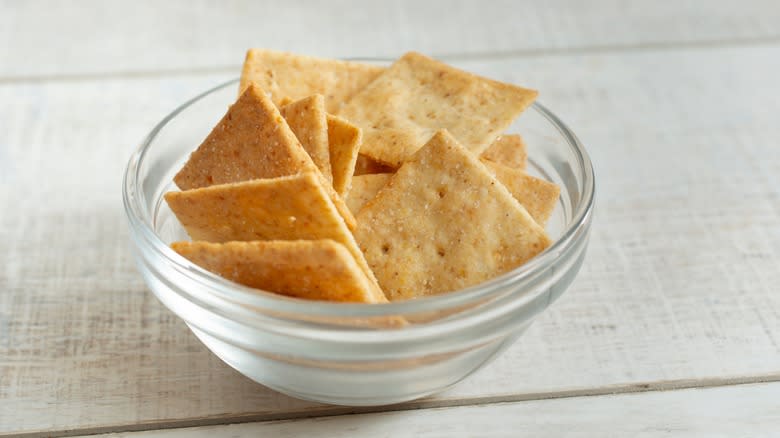
Though it has a subtle sweetness, almond meal is relatively neutral in flavor. If anything, the skins on the almonds give this food a slightly savory profile. As such, almond meal can be just as useful in savory recipes as sweet ones, including as a substitute for flour in a wide range of baked goods. For example, almond meal can be combined with oil, herbs, and various seasonings to make moreish crackers that are ideal for dipping.
Although it's more common to see almond flour, almond meal's blanched and more finely ground counterpart, in baking, there's no reason why you can't use leftover almond meal for the same purposes. Though there will be minor differences, such as a denser texture and less uniform finish, almond meal can be substituted in for almond flour in a gluten-free cracker recipe. In fact, if you prefer thicker and coarser crackers, almond meal may show itself to be not only a suitable stand-in, but perhaps an even better alternative because it can provide that extra roughage and texture for a more satisfying bite.
Create A Spicy Romesco Sauce
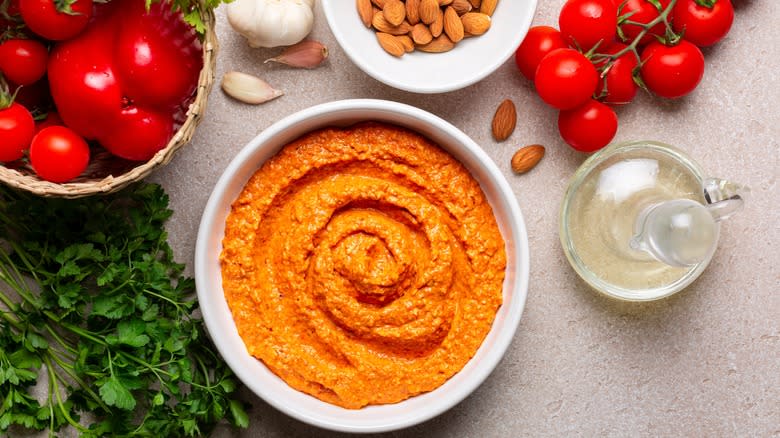
Romesco is a spicy sauce flavored with red peppers, chili, and almonds that originated in Catalonia, Spain. Its vibrant color and punchy taste makes it an attractive and tasty addition to meats and fish. But, it can also be enjoyed as a dip or a suitable pairing for pasta. It's relatively easy to make a smoky romesco sauce at home, and using almond meal in place of whole almonds is one way to reduce the prep time significantly.
You don't need to blitz the almond meal into a crumb, which makes the process of blending all of the ingredients together go by a lot quicker. After all, the soft, roasted peppers and garlic take far less time to process than whole, hard almonds. Soft, fine almond meal blends seamlessly with the veggies for a smooth sauce that's ready to be served straight away.
Though you can use plain almond meal for this sauce, part of romesco's delicious smoky taste comes from toasted almonds. To obtain this flavor, simply spread your almond meal evenly in a frying pan and gently toast the crumbs until they start to brown. Be sure to keep an eye on the pan, as the almond meal can burn quickly. Stop immediately once the meal is lightly brown and smells toasty.
Blitz It Into Almond Butter
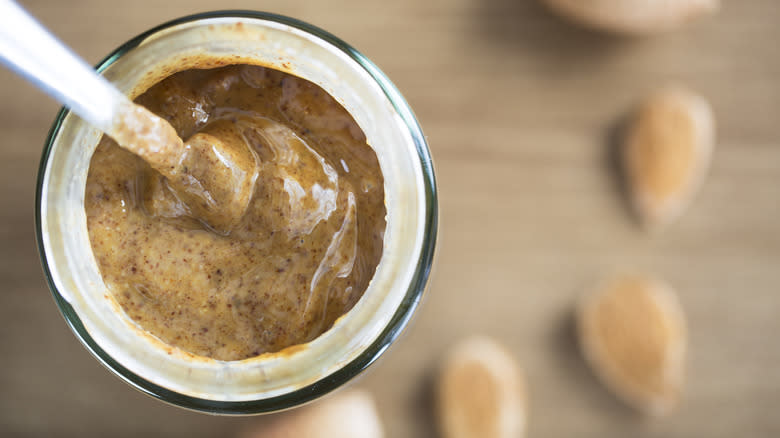
Almond meal gets you one step closer to making almond butter than whole almonds do. Turning your coarse crumbs into a luxuriously smooth spread will take you no more than five minutes and calls for no extra ingredients besides the ground almonds themselves. Transforming your leftover almond meal into almond butter is an ideal way to completely change up its texture and expand the opportunities for culinary applications. There are so many uses for creamy, rich almond butter, from topping toast to drizzling over desserts. It can also be a tasty addition to savory dishes.
To transform almond meal into almond butter, simply blitz it in a food processor until it's smooth and creamy. There's no need to add oil or any other liquids; the mixture will turn into butter with a bit of patience and time. Though, you can add spices or other ingredients to imbue your butter with extra flavor. A pinch of cinnamon will add an inviting warmth, while honey or maple syrup will give you a sweeter spread that's ideal for topping baked goods or spooning over ice cream.
Use Almond Meal In Baked Goods
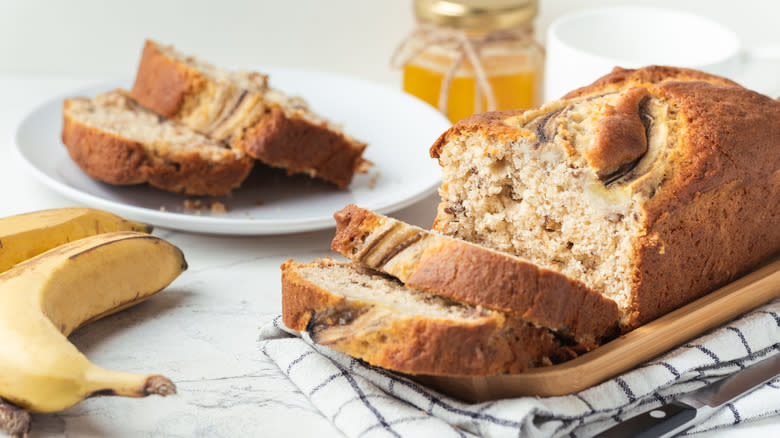
Although finer and slightly-sweeter almond flour is typically used in baking recipes, there's no doubt that almond meal has its merits when it comes to baking. Its coarse and crumbly consistency works well for dense and decadent bakes such as banana bread or muffins -- where a thicker crumb is by no means a bad thing. This ingredient also adds a subtle, yet noticeable, nuttiness to these classic bakes.
You'll need to adjust your recipes accordingly when baking with almond meal, as it does not behave in the same way as regular wheat flour. For example, you will likely find that you need to add more binding ingredients, like eggs or flax seeds, than usual.You may also need to use roughly double the amount of almond meal as regular flour. Although, the best practice is to work slowly and keep liquids on hand so that you can monitor the consistency of your batter.
If you're using almond meal in place of almond flour, however, you can use a 1-to-1 ratio, as they behave in largely the same way despite producing slightly different results. There are some recipes, though, where substituting almond meal for almond flour is not recommended. Lighter bakes, like macarons, can be weighed down by almond meal, so consider giving it a quick blitz in a food processor beforehand to produce a finer crumb. But, be aware that the skins may still leave a slight, unpleasant grittiness.
Read the original article on Tasting Table.


